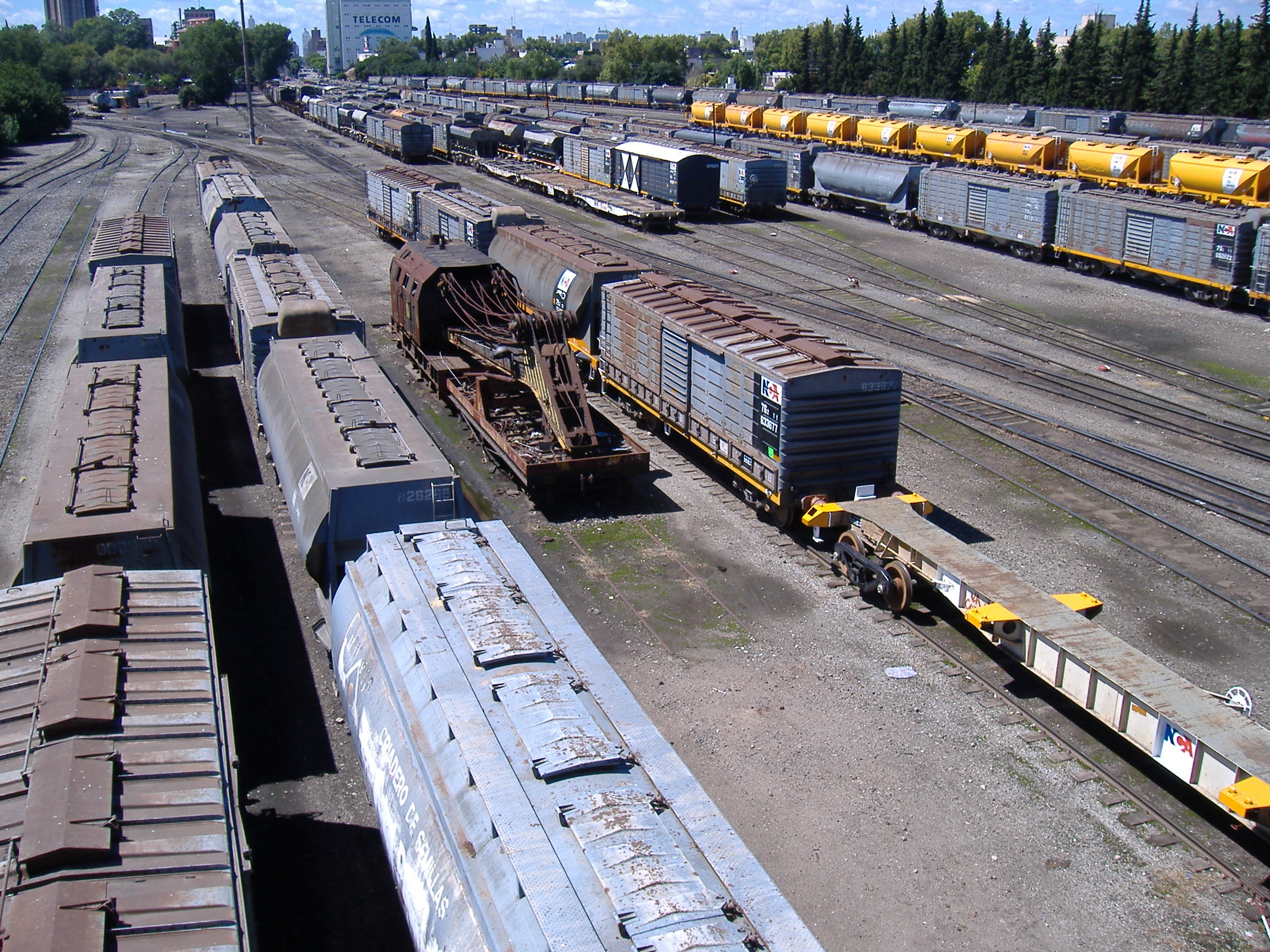|
Rosario Oeste Railway Station
Rosario Oeste is a railway station in Rosario, province of Santa Fe, Argentina. It is located in the west of the city, on the junction of Paraná St. and 9 de Julio streets. The station, part of the Belgrano Railway network, is currently operated by State-owned company Trenes Argentinos Cargas that runs freight trains to the north of Argentina. History The site of the station was originally only a stop for the line that led west to Córdoba, operated by the Córdoba Central Railway company. It was established in 1917 under the name ''Kilómetro 302'' (i.e. 302 km measured from Buenos Aires). In 1939 the State Railway Administration renamed it to "Rosario Oeste". During the mid-1940s the existing building (a wooden construction) was demolished and the new station was built, in a modern rationalist style (unlike other, older stations which followed British or French models). Rosario Oeste was designated as the local stop of all meter gauge long-distance trains that arrived i ... [...More Info...] [...Related Items...] OR: [Wikipedia] [Google] [Baidu] |
Inter-city Rail
Inter-city rail services are express passenger train services that run services that connect cities over longer distances than commuter or regional trains. There is no precise definition of inter-city rail; its meaning may vary from country to country. Most broadly, it can include any rail services that are neither short-distance commuter rail trains within one city area, nor slow regional rail trains calling at all stations and covering local journeys only. Most typically, an inter-city train is an express train with limited stops and comfortable carriages to serve long-distance travel. Inter-city rail sometimes provides international services. This is most prevalent in Europe, due to the close proximity of its 50 countries in a 10,180,000 square kilometre (3,930,000 sq mi) area. Eurostar and EuroCity are examples of this. In many European countries the word "InterCity" or "Inter-City" is an official brand name for a network of regular-interval, relatively long-distance ... [...More Info...] [...Related Items...] OR: [Wikipedia] [Google] [Baidu] |
Narrow Gauge Railway
A narrow-gauge railway (narrow-gauge railroad in the US) is a railway with a track gauge narrower than standard . Most narrow-gauge railways are between and . Since narrow-gauge railways are usually built with tighter curves, smaller structure gauges, and lighter rails, they can be less costly to build, equip, and operate than standard- or broad-gauge railways (particularly in mountainous or difficult terrain). Lower-cost narrow-gauge railways are often used in mountainous terrain, where engineering savings can be substantial. Lower-cost narrow-gauge railways are often built to serve industries as well as sparsely populated communities where the traffic potential would not justify the cost of a standard- or broad-gauge line. Narrow-gauge railways have specialised use in mines and other environments where a small structure gauge necessitates a small loading gauge. In some countries, narrow gauge is the standard; Japan, Indonesia, Taiwan, New Zealand, South Africa, and the Aust ... [...More Info...] [...Related Items...] OR: [Wikipedia] [Google] [Baidu] |
Ferrocarriles Argentinos
Ferrocarriles Argentinos (abbreviated as FA; ) was a state-owned company that managed the entire Argentine railway system for nearly 45 years. It was formed in 1948 when all the private railway companies were nationalised during Juan Perón's first presidential term, and transformed into the ''Empresa de Ferrocarriles del Estado Argentino'' (EFEA; ). FA managed both passenger and freight services, including long-distance and commuter rail trains in the metropolitan area of Buenos Aires. The company was broken up under the government of Carlos Menem following the privatisation of the railways; however in 2015 the government of Cristina Kirchner revived the brand for use on state-owned railways.Otro salto en la recuperación de soberanÃa Pagina/12, 16 April 2015. [...More Info...] [...Related Items...] OR: [Wikipedia] [Google] [Baidu] |
Rosario Norte Station
Rosario Norte is a railway station in Rosario, province of Santa Fe, Argentina. It is located on Aristóbulo del Valle Avenue, at the junction with Callao St., north of the city centre, in the neighbourhood known as Barrio Pichincha. The station, part of the Ferrocarril Mitre network, is currently operated by two companies, State-owned Operadora Ferroviaria (passenger services) and private Nuevo Central Argentino (NCA) (freight). History The station was terminus of the Buenos Aires and Rosario Railway (BARR) company. The railway line was opened in 1885 and was the first to join Rosario and Buenos Aires (about 300 km south-southeast). From Rosario Norte the line continued to the northwest, crossing several provinces of Argentina to reach Tucumán. In 1908, after the merging of the BARR and the Central Argentine Railway companies, the station was set aside to handle long-distance and express services. Around 1935–1940, a few years after the "golden age" of the Argentine railwa ... [...More Info...] [...Related Items...] OR: [Wikipedia] [Google] [Baidu] |
Patio Parada
Patio Parada is a rail yard in Rosario, province of Santa Fe, Argentina. It is an important part of the railway system of the city and has been designed as the future site of a multi-modal public transport terminus. Rosario/12, 4 March 2007''La transformación de la ciudad'' Formerly belonging to the Ferrocarril General Bartolomé Mitre company, it is now managed by the Nuevo Central Argentino (NCA) railway company. It employs a broad 5 ft 6 in (1676 mm) gauge railway. Asociación Rosarina Amigos del Riel''Historia de los Ferrocarriles de Rosario'' (History of Rosario's Railways). Overview Patio Parada is located in the north of Rosario, just outside the central section of the city, along Bordabehere Avenue, from Alberdi Avenue westward. A street bridge (part of Avellaneda Boulevard) runs above it in the north–south direction. Its administration building lies on one end, at the Cruce Alberdi (Alberdi Crossing), beside the remains of the former Ludueña Station (or Alber ... [...More Info...] [...Related Items...] OR: [Wikipedia] [Google] [Baidu] |
Railway Privatisation In Argentina
Railway privatisation in Argentina was a process which began in 1993 under the presidency of Carlos Menem, following a series of neoliberal economic reforms. This primarily consisted of breaking up the state-owned railway company Ferrocarriles Argentinos (FA) and allowing the former lines to be operated by private companies instead of the state. This policy was met with widespread criticism and proved catastrophic for the Argentine railways whose service worsened significantly in the years that followed, with entire lines closing and infrastructure deteriorating beyond repair. Privatisation was ultimately reversed in 2015 with the creation of Nuevos Ferrocarriles Argentinos. Background Since railway nationalisation in 1948, during the presidency of Juan Perón, the network had been operated by the state-owned company Ferrocarriles Argentinos (FA) which comprised the six relatively independent divisions, Sarmiento, Mitre, Urquiza, San MartÃn, Belgrano and Roca. By the time ... [...More Info...] [...Related Items...] OR: [Wikipedia] [Google] [Baidu] |
Looting
Looting is the act of stealing, or the taking of goods by force, typically in the midst of a military, political, or other social crisis, such as war, natural disasters (where law and civil enforcement are temporarily ineffective), or rioting. The proceeds of all these activities can be described as booty, loot, plunder, spoils, or pillage. During modern-day armed conflicts, looting is prohibited by international law, and constitutes a war crime.Rule 52. Pillage is prohibited. ''Customary IHL Database'', (ICRC)/ |
Rosariazo
The Rosariazo () was a protest movement that consisted in demonstrations and strikes, in Rosario, , between May and September 1969, during the military dictatorial rule of ''de facto'' President General Juan Carlos OnganÃa. The Rosariazo was caused by events in other parts of Argentina, and in turn triggered similar protests itself. Prelude There was a general climate of unrest caused by social injustice in the country. On 13 May 1969, in Tucumán, former workers of a sugar mill took the factory and its manager as hostage, asking for overdue payments. On 14 May, in Córdoba, automobile industry workers protested the elimination of the Saturday rest. On 15 May the University of Corrientes increased the price of food tickets in its cafeteria fivefold, and the ensuing protest ended up with one student, Juan José Cabral, killed by the police. First Rosariazo On 16 May 1969 the students of the Faculty of Medicine of the Universidad Nacional de Rosario expressed their rejection ... [...More Info...] [...Related Items...] OR: [Wikipedia] [Google] [Baidu] |
Train Station
A train station, railway station, railroad station or depot is a railway facility where trains stop to load or unload passengers, freight or both. It generally consists of at least one platform, one track and a station building providing such ancillary services as ticket sales, waiting rooms and baggage/freight service. If a station is on a single-track line, it often has a passing loop to facilitate traffic movements. Places at which passengers only occasionally board or leave a train, sometimes consisting of a short platform and a waiting shed but sometimes indicated by no more than a sign, are variously referred to as "stops", "flag stops", " halts", or "provisional stopping places". The stations themselves may be at ground level, underground or elevated. Connections may be available to intersecting rail lines or other transport modes such as buses, trams or other rapid transit systems. Terminology In British English, traditional terminology favours ''railway station' ... [...More Info...] [...Related Items...] OR: [Wikipedia] [Google] [Baidu] |
Nationalization
Nationalization (nationalisation in British English) is the process of transforming privately-owned assets into public assets by bringing them under the public ownership of a national government or state. Nationalization usually refers to private assets or to assets owned by lower levels of government (such as municipalities) being transferred to the state. Nationalization contrasts with privatization and with demutualization. When previously nationalized assets are privatized and subsequently returned to public ownership at a later stage, they are said to have undergone renationalization. Industries often subject to nationalization include the commanding heights of the economy – telecommunications, electric power, fossil fuels, railways, airlines, iron ore, media, postal services, banks, and water – though, in many jurisdictions, many such entities have no history of private ownership. Nationalization may occur with or without financial compensation to the former owners. ... [...More Info...] [...Related Items...] OR: [Wikipedia] [Google] [Baidu] |
Juan Perón
Juan Domingo Perón (, , ; 8 October 1895 – 1 July 1974) was an Argentine Army general and politician. After serving in several government positions, including Minister of Labour and Vice President of a military dictatorship, he was elected President of Argentina three times, serving from June 1946 to September 1955, when he was overthrown by the '' Revolución Libertadora'', and then from October 1973 until his death in July 1974. During his first presidential term (1946–1952), Perón was supported by his second wife, Eva Duarte ("Evita"): they were immensely popular among the Argentine working class. Perón's government invested heavily in public works, expanded social welfare, and forced employers to improve working conditions. Trade unions grew rapidly with his support and women's suffrage was granted with Eva's influence. On the other hand, dissidents were fired, exiled, arrested and tortured, and much of the press was closely controlled. Several high-profile war crimin ... [...More Info...] [...Related Items...] OR: [Wikipedia] [Google] [Baidu] |






.jpg)